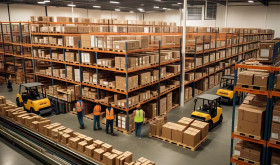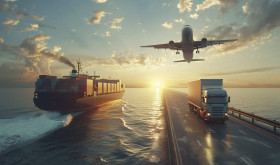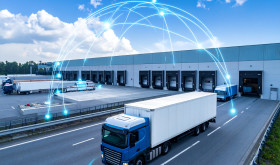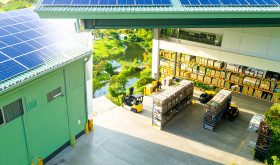
The Asia-Pacific region stands out as one of the world’s busiest logistics hubs, characterised by booming economies, trade routes that cross borders, a wide range of landscapes, and crowded city centres. These factors make moving goods tricky—but also create lots of chances for growth. As companies that make products, sell them, handle shipping, and move freight expand their operations, multi-modal freight orchestration has become a key skill. This approach boosts productivity, helps businesses bounce back from problems, and lets them see what’s happening across their supply chains.
Multi-modal freight orchestration means planning, carrying out, and improving freight across different transport types—road, sea, rail, air, and inland waterways. This approach ensures smooth data flow and unified decision-making. In the Asia-Pacific (APAC) region, it has an impact on the traditional transport management system. A transport management system is changing from a simple tracking platform to a powerful integrated logistics command centre that can handle complex end-to-end movements.
- Why Multi-Modal Orchestration Matters in APAC
a) Fragmented transport networks and diverse geographies
The Asia-Pacific area covers packed big cities, mountain borders, huge island groups, and remote hinterlands. Goods often move through several types of transport in one trip—from truck to ship and back to truck. Without an up-to-date transport management system, companies deal with fragmented work processes, siloed data, and slow reactions to holdups. Smart coordination across different transport types, driven by an intelligent transport management system, makes sure all transport events come together in one operational picture.
b) Growing cross-border trade corridors
Trade agreements like RCEP and AFTA speed up how goods move around a region. As more goods cross borders, companies need to rely on networks that use different ways to transport things. A well-integrated transport management system that works well together helps plan cross-border movements, harmonise documentation, streamline customs processes, and pick the best way to move things to manage cost volatility.
c) Pressure for faster fulfilment and flexible routing
Some of the world’s fastest-growing online shopping markets are in APAC. Buyers want their stuff the next day, to see where it is all the time, and cheap shipping—even between countries. With multi-modal orchestration within a robust transport management system, companies can switch carriers mid-route, bypass congested ports, or find better routes to meet demanding service levels.
d) Rising sustainability and carbon reporting requirements
Governments in the Asia-Pacific region are making environmental standards stricter. Multi-modal routing helps companies move shipments from trucks to trains or ships, cutting down on emissions. By adding sustainability metrics into a transport management system, businesses can track CO₂ output for each route and mode, which helps them meet their ESG commitments.
- How Multi-Modal Freight Orchestration Works
To orchestrate multi-modal freight well, you need a mix of technology, connected data, and integrated processes—all built around a top-notch transport management system.
a) Unified transport management system with multi-modal capabilities
Modern TMS platforms offer:
- Mode-specific operational workflows (air AWB, ocean BL, rail timetables)
- Route optimisation that changes across multiple modes
- Carrier allocation and capacity planning
- Shipment life-cycle visibility from start to finish
Instead of setting up different systems for each mode, companies centralise workflows through one complete transport management system.
b) Real-time data and IoT-enabled visibility
Visibility plays a key role in multi-modal shipments. When freight changes modes, geographies, and carriers, data in real time—GPS truck tracking, vessel AIS updates, flight milestones, and rail-event messages—goes straight into the transport management system. This allows for accurate ETA predictions and quicker exception resolution.
c) API-based integration with carriers and partners
APAC’s shipping scene includes countless small carriers with different levels of tech savvy. Smooth multi-mode coordination needs seamless API or EDI links between the transport management system, shipping agents, train companies, airlines, storage yards, and customs portals. This stops data gaps, cuts down on human mistakes, and makes sure every event is recorded.
d) AI-driven planning and optimisation
AI boosts the transport management system by offering smart route selection, auto-ranking of carriers, live traffic checks, and “what-if” testing. This helps planners get ahead of problems—like busy ports or weather holdups—and change routes.
- Key Benefits for Asia-Pacific Supply Chains
a) Reduced cost through optimal mode selection
Multi-modal orchestration lets companies move freight using the cheapest modes. A smart transport management system compares speed, cost, carbon output, and dependability to pick the best mix of modes.
b) Faster delivery through alternative routing
Ports often get backed up, and borders clog in APAC. Orchestration allows planners to redirect containers, choose different ports, or switch segments to air for time-sensitive shipments—all coordinated through the transport management system.
c) Increased operational resilience
Natural disasters, political changes, and supply-chain volatility hit APAC often. Multi-modal orchestration backed by a single transport management system helps companies stay flexible by allowing them to use various modes and change routes.
d) Stronger compliance and sustainability reporting
CO₂ emissions change a lot depending on the transport method. A transport management system can calculate emissions for each possible route, which helps companies reach their sustainability goals and follow local environmental regulations.
e) Harmonised documentation and customs compliance
Moving freight across different modes of transport involves lots of complex documents. A central transport management system generates documents , keeps data accurate, and speeds up customs clearance.
- APAC-Specific Challenges and Opportunities
a) Fragmented carrier market
Small and medium-sized businesses run most of the region’s logistics sector, which makes going digital tough. But transport management system providers have a big chance to make workflows the same across these fragmented companies.
b) Rapid e-commerce expansion
Cross-border e-commerce shipping needs adaptable options across different transport modes. Software that manages transport helps handle busy periods, returns, and sudden demand spikes.
c) Massive infrastructure developments
New routes, roads, train tracks, and high-tech ports across Southeast Asia, China, and India will offer more shipping choices. Companies will need smart transport management tools to make the most of these new options.
d) Digitalisation of ports and customs
As Asia-Pacific ports adopt online systems, linking up with transport management software becomes a keyway to stand out and ensure quick and reliable cargo movement.
- The Road Ahead: Future Directions
The coordination of different transport types in Asia-Pacific will keep changing. Some new ideas on the horizon include:
- Digital twins to simulate corridors in real time
- Adding autonomous trucks and drones to transport management system processes
- Multi-modal paperwork backed by blockchain
- AI to predict and handle exceptions
- Platforms for shippers and carriers to work together and orchestrate in real time
The next wave of transport management systems will shift towards making logistics decisions on their own, cutting down on manual planning and boosting network flexibility.
- Conclusion
Multi-modal freight coordination has an influence on Asia-Pacific supply chains. The region’s geography, trade intensity, and logistical complexity require a smarter, connected approach to plan and execute. By merging live updates, API links, AI-driven improvements, and strong sustainability metrics within a modern transport management system, companies can reduce costs, speed up delivery, boost resilience, and improve compliance.
For APAC businesses—in manufacturing, distributing, retailing, or online shopping—the future of moving goods depends on smooth freight handling across roads, seas, skies, and rails through smart, unified multi-modal coordination.










